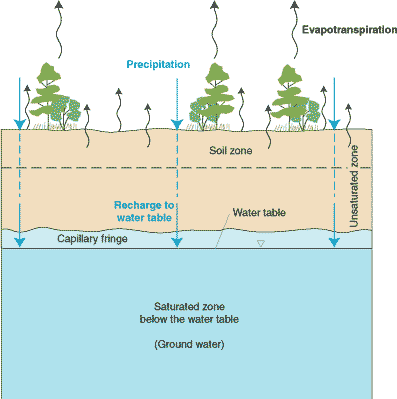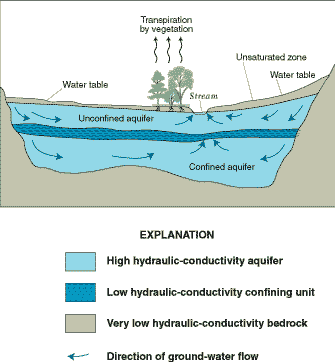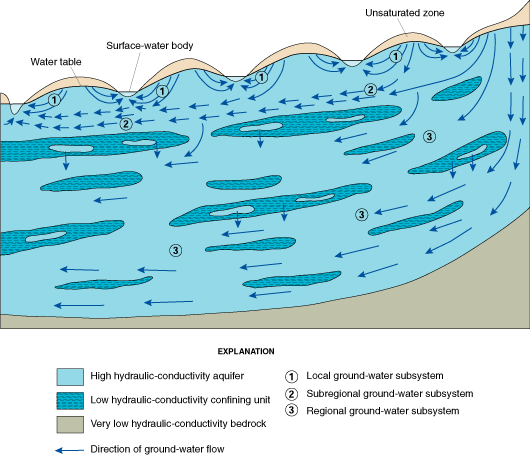GENERAL FACTS AND CONCEPTS ABOUT GROUND WATER
- Ground water occurs almost everywhere beneath the land surface. The widespread occurrence of potable ground water is the reason that it is used as a source of water supply by about one-half the population of the United States, including almost all of the population that is served by domestic water-supply systems.
- Natural sources of freshwater that become ground water are (1) areal recharge from precipitation that percolates through the unsaturated zone to the water table (Figure 4) and (2) losses of water from streams and other bodies of surface water such as lakes and wetlands. Areal recharge ranges from a tiny fraction to about one-half of average annual precipitation. Because areal recharge occurs over broad areas,even small average rates of recharge (for example, a few inches per year) represent significant volumes of inflow to ground water. Streams and other surface-water bodies may either gain water from ground water or lose (recharge) water to ground water. Streams commonly are a significant source of recharge to ground water downstream from mountain fronts and steep hillslopes in arid and semiarid areas and in karst terrains (areas underlain by limestone and other soluble rocks).

Figure 4. The unsaturated zone, capillary fringe, water table, and saturated zone.
Water beneath the land surface occurs in two principal zones, the unsaturated zone and the saturated zone. In the unsaturated zone, the spaces between particle grains and the cracks in rocks contain both air and water. Although a considerable amount of water can be present in the unsaturated zone, this water cannot be pumped by wells because capillary forces hold it too tightly.
In contrast to the unsaturated zone, the voids in the saturated zone are completely filled with water. The approximate upper surface of the saturated zone is referred to as the water table. Water in the saturated zone below the water table is referred to as ground water. Below the water table, the water pressure is high enough to allow water to enter a well as the water level in the well is lowered by pumping, thus permitting ground water to be withdrawn for use.
Between the unsaturated zone and the water table is a transition zone, the capillary fringe. In this zone, the voids are saturated or almost saturated with water that is held in place by capillary forces.
- The top of the subsurface ground-water body, the water table, is a surface, generally below the land surface, that fluctuates seasonally and from year to year in response to changes in recharge from precipitation and surface-water bodies. On a regional scale, the configuration of the water table commonly is a subdued replica of the land-surface topography. The depth to the water table varies. In some settings, it can be at or near the land surface; for example, near bodies of surface water in humid climates. In other settings, the depth to the water table can be hundreds of feet below land surface.
- Ground water commonly is an important source of surface water. The contribution of ground water to total streamflow varies widely among streams, but hydrologists estimate the average contribution is somewhere between 40 and 50 percent in small and medium-sized streams. Extrapolation of these numbers to large rivers is not straightforward; however, the ground-water contribution to all streamflow in the United States may be as large as 40 percent. Ground water also is a major source of water to lakes and wetlands.
- Ground water serves as a large subsurface water reservoir. Of all the freshwater that exists, about 75 percent is estimated to be stored in polar ice and glaciers and about 25 percent is estimated to be stored as ground water. Freshwater stored in rivers, lakes, and as soil moisture amounts to less than 1 percent of the world's freshwater. The reservoir aspect of some large ground-water systems can be a key factor in the development of these systems. A large ratio of total ground-water storage either to ground-water withdrawals by pumping or to natural discharge is one of the potentially useful characteristics of a ground-water system and enables water supplies to be maintained through long periods of drought. On the other hand, high ground-water use in areas of little recharge sometimes causes widespread declines in ground-water levels and a significant decrease in storage in the ground-water reservoir.
- Velocities of ground-water flow generally are low and are orders of magnitude less than velocities of streamflow. The movement of ground water normally occurs as slow seepage through the pore spaces between particles of unconsolidated earth materials or through networks of fractures and solution openings in consolidated rocks. A velocity of 1 foot per day or greater is a high rate of movement for ground water, and ground-water velocities can be as low as 1 foot per year or 1 foot per decade. In contrast, velocities of streamflow generally are measured in feet per second. A velocity of 1 foot per second equals about 16 miles per day. The low velocities of ground-water flow can have important implications, particularly in relation to the movement of contaminants.
- Under natural conditions, ground water moves along flow paths from areas of recharge to areas of discharge at springs or along streams, lakes, and wetlands. Discharge also occurs as seepage to bays or the ocean in coastal areas, and as transpiration by plants whose roots extend to near the water table. The three-dimensional body of earth material saturated with moving ground water that extends from areas of recharge to areas of discharge is referred to as a ground-water-flow system (Figure 5).

Figure 5. A local scale ground-water-flow system.
In this local scale ground-water-flow system,inflow of water from areal recharge occurs at the water table. Outflow of water occurs as (1) discharge to the atmosphere as ground-water evapotranspiration (transpiration by vegetation rooted at or near the water table or direct evaporation from the water table when it is at or close to the land surface) and (2) discharge of ground water directly through the streambed. Short, shallow flow paths originate at the water table near the stream. As distance from the stream increases, flow paths to the stream are longer and deeper. For long-term average conditions, inflow to this natural ground-water system must equal outflow.
- The areal extent of ground-water-flow systems varies from a few square miles or less to tens of thousands of square miles. The length of ground-water-flow paths ranges from a few feet to tens, and sometimes hundreds, of miles. A deep ground-water-flow system with long flow paths between areas of recharge and discharge may be overlain by, and in hydraulic connection with, several shallow, more local, flow systems (Figure 6). Thus, the definition of a ground-water-flow system is to some extent subjective and depends in part on the scale of a study.
Figure 6. A regional ground-water-flow system that comprises subsystems at different scales and a complex hydrogeologic framework. (Modified from Sun, 1986.)
Significant features of this depiction of part of a regional ground-water-flow system include (1) local ground-water subsystems in the upper water-table aquifer that discharge to the nearest surface-water bodies (lakes or streams) and are separated by ground-water divides beneath topographically high areas; (2) a subregional ground-water subsystem in the water-table aquifer in which flow paths originating at the water table do not discharge into the nearest surface-water body but into a more distant one; and (3) a deep, regional ground-water-flow subsystem that lies beneath the water-table subsystems and is hydraulically connected to them. The hydrogeologic framework of the flow system exhibits a complicated spatial arrangement of high hydraulic-conductivity aquifer units and low hydraulic-conductivity confining units. The horizontal scale of the figure could range from tens to hundreds of miles.
- The age (time since recharge) of ground water varies in different parts of ground-water-flow systems. The age of ground water increases steadily along a particular flow path through the ground-water-flow system from an area of recharge to an area of discharge. In shallow, local-scale flow systems, ages of ground water at areas of discharge can vary from less than a day to a few hundred years. In deep, regional flow systems with long flow paths (tens of miles), ages of ground water may reach thousands or tens of thousands of years.
- Surface and subsurface earth materials are highly variable in their degree of particle consolidation, the size of particles, the size and shape of pore or open spaces between particles and between cracks in consolidated rocks, and in the mineral and chemical composition of the particles. Ground water occurs both in loosely aggregated and unconsolidated materials, such as sand and gravel, and in consolidated rocks, such as sandstone, limestone, granite, and basalt.
- Earth materials vary widely in their ability to transmit and store ground water. The ability of earth materials to transmit ground water (quantified as hydraulic conductivity) varies by orders of magnitude and is determined by the size, shape, interconnectedness, and volume of spaces between solids in the different types of materials. For example, the interconnected pore spaces in sand and gravel are larger than those in finer grained sediments, and the hydraulic conductivity of sand and gravel is larger than the hydraulic conductivity of the finer grained materials. The ability of earth materials to store ground water also varies among different types of materials. For example, the volume of water stored in cracks and fractures per unit volume of granite is much smaller than the volume stored per unit volume in the intergranular spaces between particles of sand and gravel.
- Wells are the principal direct window to study the subsurface environment. Not only are wells used to pump ground water for many purposes, they also provide essential information about conditions in the subsurface. For example, wells (1) allow direct measurement of water levels in the well, (2) allow sampling of ground water for chemical analysis, (3) provide access for a large array of physical measurements in the borehole (borehole geophysical logging) that give indirect information on the properties of the fluids and earth materials in the neighborhood of the well, and (4) allow hydraulic testing (aquifer tests) of the earth materials in the neighborhood of the well to determine local values of their transmitting and storage properties. In addition, earth materials can be sampled directly at any depth during the drilling of the well.
- Pumping ground water from a well always causes (1) a decline in ground-water levels (heads; see Figure 7) at and near the well, and (2) a diversion to the pumping well of ground water that was moving slowly to its natural, possibly distant, area of discharge. Pumping of a single well typically has a local effect on the ground-water-flow system. Pumping of many wells (sometimes hundreds or thousands of wells) in large areas can have regionally significant effects on ground-water systems.

Figure 7. The concept of "hydraulic head" or "head" at a point in an aquifer.
Consider the elevations above sea level at points A and B in an unconfined aquifer and C in a confined aquifer. Now consider the addition of wells with short screened intervals at these three points. The vertical distance from the water level in each well to sea level is a measure of hydraulic head or head, referenced to a common datum at each point A, B, and C, respectively. Thus, head at a point in an aquifer is the sum of (a) the elevation of the point above a common datum, usually sea level, and (b) the height above the point of a column of static water in a well that is screened at the point. When we discuss declines or rises in ground-water levels in a particular aquifer in this report, we are referring to changes in head or water levels in wells that are screened or have an open interval in that aquifer.
- Ground-water heads respond to pumping to markedly different degrees in unconfined and confined aquifers. Pumping the same quantity of water from wells in confined and in unconfined aquifers initially results in much larger declines in heads over much larger areas for the confined aquifers (see Box A). This is because less water is available from storage in confined aquifers compared to unconfined aquifers. At a later time, as the amount of water derived from storage decreases and the system approaches equilibrium, the response of the system no longer depends upon being confined or unconfined. The amount of head decline at equilibrium is a function of the transmitting properties of the aquifers and confining units, discharge rate of the well, and distance to ground-water-system boundaries. Many aquifers, such as the upper part of the deep flow subsystem shown in Figure 6, exhibit a response to pumping that is intermediate between a completely confined and a completely unconfined aquifer system.




No comments:
Post a Comment